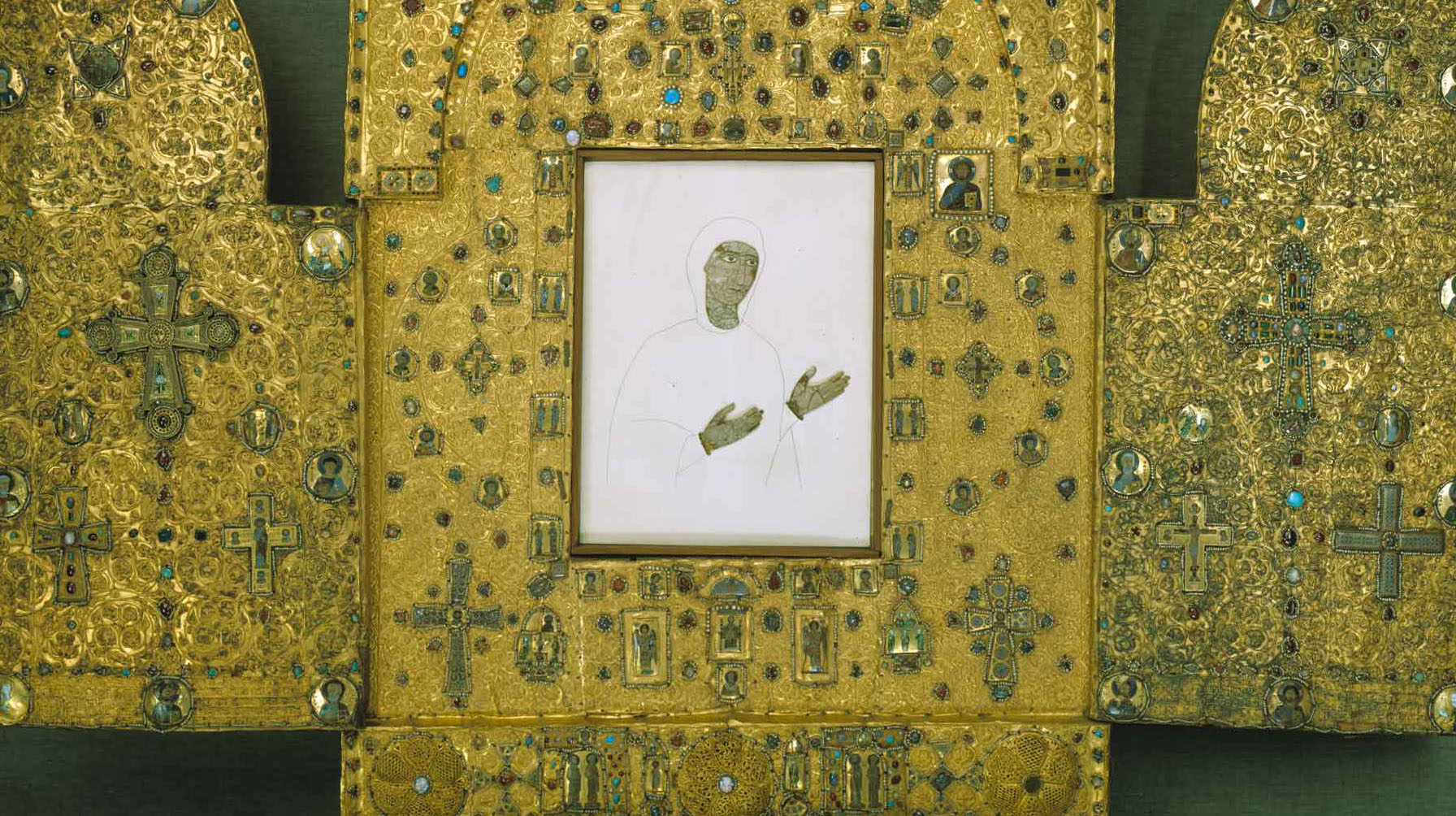
Feel free to add tags, names, dates or anything you are looking for


The triptych created for the enameled image of the supplicating Virgin, originally belonging to Khakhuli monastery in southwest Georgia, is one of the most brilliant “royal” icons created in medieval Georgia (its size with open wings is 2x1,47m., the central part is gold, the lateral wings of gold and silver alloy – electrum; The icon is housed at the Georgian National Museum of fine Arts, Tbilisi). The central image of the Virgin is dated back to the 10th century, while the splendid three-part mounting-case was created in the first half of the 12th c. Today only the enameled face and palms survive from the figure of the Mother of God. It is supposed that the other parts of the icon were executed in repoussé.

The Mother of God, central image of Khakhuli triptych, 10th century.

Khakhuli Triptych, Georgian National Museum
The original parts of triptych, the fragments of silver repoussé revetment, decorate the outer surface of the wings. In 1106 the icon of the Virgin was transferred by King David IV Builder (1073-1125) from Khakhuli monastery (founded in the 2nd half of 10th c by David Kouropalates, d. 1001.) to the new royal monastery of Gelati, near Kutaisi, the capital of Georgia of that time. Gelati was established as a royal monastery designated to be a dynastic mausoleum of the ruling family of Bagrationi. According to the historian of David the Builder, he donated to monastery lands, holy relics, icons and liturgical objects. After the death of David IV his son Demetre I (1125-1154) commissioned a lavishly adorned mounting-case for the icon: a triptych sheathed in gilt silver and gold repoussé revetment encrusted with 115 enamels of various times and provenance, precious stones and gems.

Cloisonné enamel plaque with the Virgin, 9th-10th cc.
The triptych is supplied with extensive commissioner’s inscription in Georgian script. The transfer of the Virgin’s miracle-working image from Khakhuli monastery to Gelati, enhanced the royal monastery and gave to it additional grace and spiritual importance. According to a 17th century travelers’ account, the icon was installed near the sanctuary of the main church of Gelati Monastery. The triptych is embellished with Byzantine and Georgian medieval cloisonné enamels depicting a wide range of subjects: images of Christ, various types of the Virgin, Holy Apostles, Saints, historical persons, symbolic images, and ornamental motives. Among the embellishments are dissembled precious objects: crosses, reliquaries, icons and crowns.

Part of the True Cross reliquary of Kvirike, ruler of Kakheti, 10th century.
The sophisticated and refined golden repoussé vegetal ornamentation together with the glittering multicoloured enamels create a mystical setting for the main image. The vine-scroll, a predominant motive of repoussé revetment symbolizes Paradise. The spiritual and ideological message of the icon could be interpreted in a variety of ways, but the main idea is glorification of the central image of the Mother of God supplicating for mankind. The enameled decoration of the triptych is based on a complex ideological concept. The layout of the enameled plaques displays an important message. The prominent position of the panel with the Byzantine imperial couple – representing Emperor Michael VII and his consort Empress Maria, aunt of David IV, who later married Byzantine Emperor Nikephoros III Botaneiates, is placed at the top of the central panel, at the highest place of the icon.

Cloisonné enamel plaque with Byzantine Emperor Michael VII and Maria Bagrationi, 11th century.
The mentioned plaque together with a cross with Constantine and Helena and two other plaques with enthroned Christ inserted into the central part of the triptych, create a visual and ideological axis of the entire composition and underline the idea of rulership and power. The enamelled plaque with the Virgin blessing two unidentified female figures clad in Byzantine imperial costume, resonates with the idea of the Godly chosen rulers elaborated in the medieval period.

Cloisonné enamel Plaque depicting two female rulers being blessed by the Virgin, 11th-12th cc.
The large crosses, three on each lateral wings of the triptych and two in the lower part of the central part, capture the viewers’ attention and stress the Salvational sacrifice of the Saviour.
The icon of the supplicating Virgin is connected with the Holy Reliquary (Agia soros) containing the precious Marian relic – her garment, which was kept in one of the monasteries of Constantinople. It is not accidental that David IV, the powerful monarch of the unified Kingdom of Georgia, chose the icon representing the Virgin in supplication as his icon. The meaning of the depicted interceding Mother of God and her association with the Byzantine capital clearly reflect the ambitions of King David, who after brilliant victories over the Seljuks, powerful enemies of Christians, viewed himself as the principle protector of Christians in the region.